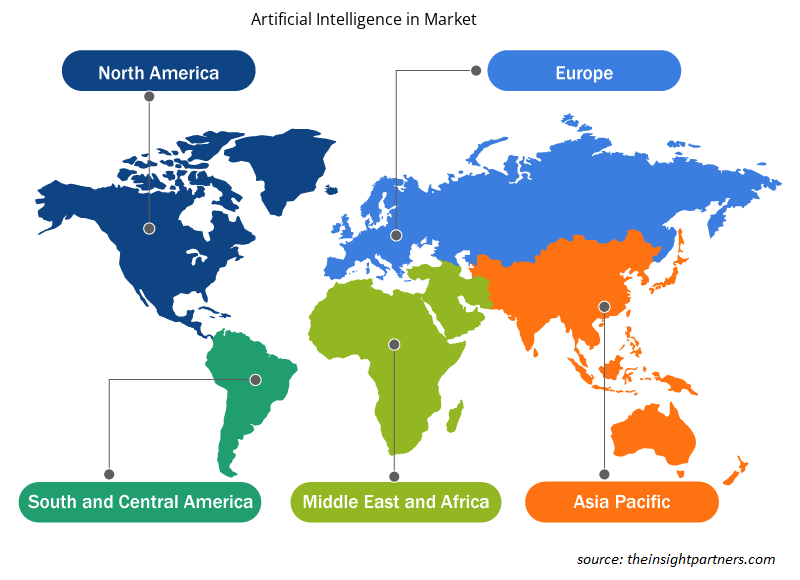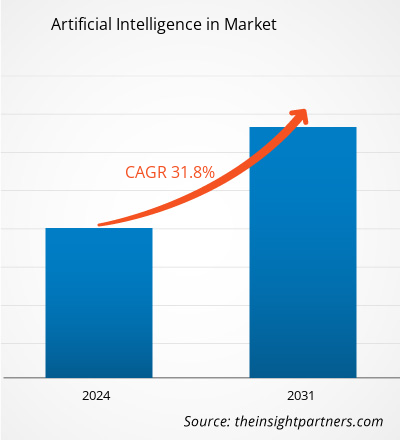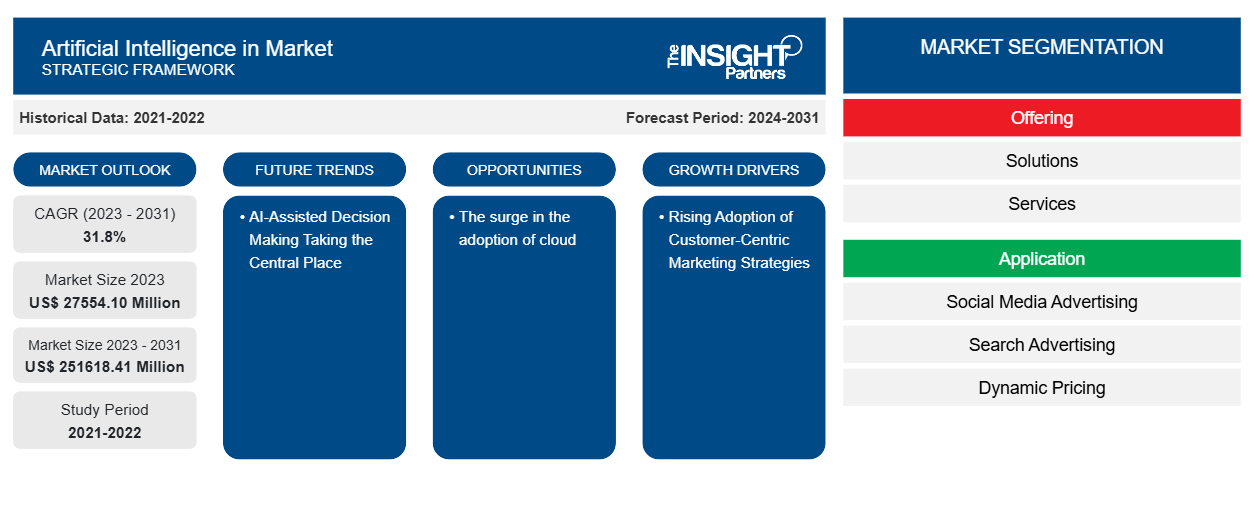Der Markt für künstliche Intelligenz im Marketing soll von 27.554,10 Millionen US-Dollar im Jahr 2023 auf 251.618,41 Millionen US-Dollar im Jahr 2031 anwachsen. Der Markt wird zwischen 2023 und 2031 voraussichtlich eine durchschnittliche jährliche Wachstumsrate (CAGR) von 31,8 % verzeichnen. KI-gestützte Entscheidungsfindung wird voraussichtlich weiterhin ein wichtiger Trend auf dem Markt bleiben.
Künstliche Intelligenz in der Marketing-Marktanalyse
Die zunehmende Nutzung von Social-Media-Plattformen für Werbung und die zunehmende Einführung kundenorientierter Marketingstrategien sind einige der Faktoren, die das Wachstum des Marktes für künstliche Intelligenz im Marketing fördern. Der Mangel an Personal mit umfassenden Kenntnissen in KI behindert jedoch das Marktwachstum. Darüber hinaus schafft die zunehmende Einführung cloudbasierter Anwendungen und Dienste bemerkenswerte Chancen für Akteure des Marketingmarktes, die künstliche Intelligenz einsetzen.
Künstliche Intelligenz im Marketing – Marktübersicht
Technologien der künstlichen Intelligenz (KI) werden im Marketing eingesetzt, um automatisierte Entscheidungen auf der Grundlage von Datenerfassung, Analyse und Beobachtungen zusätzlicher Zielgruppen oder wirtschaftlicher Trends zu unterstützen, die sich auf Marketingkampagnen auswirken könnten. KI wird häufig in digitalen Marketingkampagnen eingesetzt, wenn Effizienz entscheidend ist. Wenn Geschwindigkeit bei digitalen Marketingbemühungen entscheidend ist, wird häufig generative KI eingesetzt. KI-Marketinglösungen lernen anhand von Daten und Kundenprofilen, wie sie am effektivsten mit Kunden interagieren. Sie übermitteln dann im richtigen Moment personalisierte Nachrichten ohne die Hilfe von Marketingteammitarbeitern und garantieren so optimale Produktivität. Generative KI wird von einer großen Anzahl moderner digitaler Vermarkter eingesetzt, um ihre Teams zu unterstützen oder taktischere Aktivitäten durchzuführen, die weniger menschliches Feingefühl erfordern.
Passen Sie diesen Bericht Ihren Anforderungen an
Sie erhalten kostenlos individuelle Anpassungen an jedem Bericht, einschließlich Teilen dieses Berichts oder einer Analyse auf Länderebene, eines Excel-Datenpakets sowie tolle Angebote und Rabatte für Start-ups und Universitäten.
-
Holen Sie sich die wichtigsten Markttrends aus diesem Bericht.Dieses KOSTENLOSE Beispiel umfasst eine Datenanalyse von Markttrends bis hin zu Schätzungen und Prognosen.
Künstliche Intelligenz im Marketing – Markttreiber und Chancen
Zunehmende Einführung kundenzentrierter Marketingstrategien
Um auf dem hart umkämpften globalen Markt erfolgreich zu sein, konzentrieren sich viele Unternehmen, unabhängig von ihrer Branche, auf den Aufbau langfristiger, für beide Seiten vorteilhafter Beziehungen zu ihren Kunden. Der Schwerpunkt der Taktiken und Maßnahmen zur Kundenbindung hat sich in den letzten Jahren von einer hauptsächlich produktorientierten zu einer stärker kundenorientierten Strategie gewandelt. Durch die Einführung eines kundenorientierten Ansatzes können Unternehmen die Anforderungen ihrer Kunden jederzeit vorhersehen und besser erfüllen. Unternehmen, die erfolgreich auf kundenorientiertes Engagement umgestiegen sind, haben nachweislich einen erheblichen Wettbewerbsvorteil sowie höhere Umsätze und Erträge. Laut Harvard Business Review haben mehr als ein Drittel der Fortune 500-Unternehmen ihre Umstrukturierung mit Blick auf den Kunden vorgenommen und dabei Kundenreisen, Präferenzen und Segmentierung als treibende Prinzipien verwendet. Viele bekannte Unternehmen haben sich in den letzten Jahren jedoch erfolgreich der Kundenorientierung verschrieben. Zu den beliebten kundenorientierten Unternehmen in den USA gehören USAA, Tumi und American Express. Fluggesellschaften wie Singapore Airlines, Air Innovative Zealand und Emirates geben ihre traditionellen Methoden zugunsten innovativer Werbeformen auf.
Der Anstieg der Nutzung von Cloud-
Für Cloud-Benutzer hat sich künstliche Intelligenz (KI) zu einem multifunktionalen Tool für Datenmanagement, Sicherheit, Datenanalyse und strategische Entscheidungsfindung entwickelt. Die Fähigkeit, maschinelles Lernen zu nutzen und objektive Interpretationen datengesteuerter Erkenntnisse zu erstellen, erhöht die Effizienz dieser Verfahren und spart dem Unternehmen viel Geld. Durch die Verwendung von KI-Software, die auf Algorithmen des maschinellen Lernens in Cloud-Umgebungen basiert, können Unternehmen Benutzern und Verbrauchern vernetzte und benutzerfreundliche Erfahrungen bieten. Daher schafft der Anstieg der Cloud-Nutzung verschiedene Chancen für den Markt.
Künstliche Intelligenz im Marketing-Marktbericht – Segmentierungsanalyse
Wichtige Segmente, die zur Herleitung künstlicher Intelligenz in der Marketingmarktanalyse beigetragen haben, sind Angebots-, Anwendungs- und Endverbrauchsbranche.
- Basierend auf dem Angebot wird der Markt für künstliche Intelligenz im Marketing in Lösungen und Dienstleistungen unterteilt. Das Segment Lösungen hatte im Jahr 2023 einen größeren Marktanteil.
- Nach Anwendung ist der Markt in Social-Media-Werbung, Suchmaschinenwerbung, dynamische Preisgestaltung, virtuelle Assistenten, Content Curation, Vertriebs- und Marketingautomatisierung, Analyseplattformen und andere unterteilt. Das Segment Social-Media-Werbung hatte im Jahr 2023 einen größeren Marktanteil.
Nach Endverbrauchsbranche ist der Markt in BFSI, Einzelhandel, Konsumgüter, Medien und Unterhaltung und Sonstige segmentiert.
Künstliche Intelligenz im Marketing – Marktanteilsanalyse nach geografischer Lage
Der geografische Umfang des Marktberichts über künstliche Intelligenz im Marketing ist hauptsächlich in fünf Regionen unterteilt: Nordamerika, Asien-Pazifik, Europa, Naher Osten und Afrika sowie Süd- und Mittelamerika.
Nordamerika dominiert den Markt für künstliche Intelligenz im Marketing. Die wichtigsten Akteure auf dem Markt für künstliche Intelligenz im Marketing, wie Adobe, Amazon Web Services, IBM, Salesforce und Accenture, haben verschiedene organische und anorganische Strategien verfolgt, um ihren Umsatz und ihre Marktposition zu verbessern. So hat Appier im Januar 2021 ARTIFICIAL INTELLIGENCEXPERT auf den Markt gebracht, einen appbasierten Werbeassistenten auf Basis von KÜNSTLICHER INTELLIGENZ, der Vermarktern hilft, die Leistung ihrer Verkaufskampagnen mithilfe von campArtificial Intelligencegns problemlos zu skalieren. Der Markt in der Region wächst also.
Umfang des Marktberichts über künstliche Intelligenz im Marketing
Künstliche Intelligenz in regionalen Markteinblicken
Die regionalen Trends und Faktoren, die den Markt für künstliche Intelligenz im gesamten Prognosezeitraum beeinflussen, wurden von den Analysten von Insight Partners ausführlich erläutert. In diesem Abschnitt werden auch Marktsegmente und Geografien für künstliche Intelligenz in Nordamerika, Europa, im asiatisch-pazifischen Raum, im Nahen Osten und Afrika sowie in Süd- und Mittelamerika erörtert.

- Erhalten Sie regionalspezifische Daten zum Thema künstliche Intelligenz auf dem Markt
Künstliche Intelligenz im Marktberichtsumfang
| Berichtsattribut | Details |
|---|---|
| Marktgröße im Jahr 2023 | 27554,10 Millionen US-Dollar |
| Marktgröße bis 2031 | 251.618,41 Millionen US-Dollar |
| Globale CAGR (2023 - 2031) | 31,8 % |
| Historische Daten | 2021-2022 |
| Prognosezeitraum | 2024–2031 |
| Abgedeckte Segmente |
Durch das Angebot
|
| Abgedeckte Regionen und Länder |
Nordamerika
|
| Marktführer und wichtige Unternehmensprofile |
|
Künstliche Intelligenz in der Marktakteursdichte: Ihre Auswirkungen auf die Geschäftsdynamik verstehen
Der Markt für künstliche Intelligenz wächst rasant. Dies wird durch die steigende Nachfrage der Endnutzer aufgrund von Faktoren wie sich entwickelnden Verbraucherpräferenzen, technologischen Fortschritten und einem größeren Bewusstsein für die Vorteile des Produkts vorangetrieben. Mit der steigenden Nachfrage erweitern Unternehmen ihr Angebot, entwickeln Innovationen, um die Bedürfnisse der Verbraucher zu erfüllen, und nutzen neue Trends, was das Marktwachstum weiter ankurbelt.
Die Marktteilnehmerdichte bezieht sich auf die Verteilung der Firmen oder Unternehmen, die in einem bestimmten Markt oder einer bestimmten Branche tätig sind. Sie gibt an, wie viele Wettbewerber (Marktteilnehmer) in einem bestimmten Marktraum im Verhältnis zu seiner Größe oder seinem gesamten Marktwert präsent sind.
Die wichtigsten auf dem Markt für künstliche Intelligenz tätigen Unternehmen sind:
- Affektiv
- Appier Inc.
- Bidalgo
- Novantas (Amplero) Inc.
- Kognitive Skala
- SAS Institute Inc.
Haftungsausschluss : Die oben aufgeführten Unternehmen sind nicht in einer bestimmten Reihenfolge aufgeführt.

- Überblick über die wichtigsten Akteure auf dem Markt für künstliche Intelligenz
Künstliche Intelligenz im Marketing – Marktnachrichten und aktuelle Entwicklungen
Künstliche Intelligenz im Marketingmarkt wird durch das Sammeln qualitativer und quantitativer Daten nach Primär- und Sekundärforschung bewertet, die wichtige Unternehmensveröffentlichungen, Verbandsdaten und Datenbanken umfasst. Nachfolgend sind einige der Entwicklungen im Bereich künstliche Intelligenz im Marketingmarkt aufgeführt:
- Clarivate Plc, ein weltweit führender Anbieter transformativer Intelligenz, hat heute auf der Jahrestagung der International Trademark Association 2024 die erste öffentlich verfügbare Version des Trademark Watch Analyzer vorgestellt. Als Markenschutzlösung der nächsten Generation, die durch künstliche Intelligenz (KI) und Cloud-Technologie verbessert wird, kombiniert diese Lösung Clarivates globale Marken- und Rechtsprechungsdaten, interne IP-Expertise und modernste KI-Technologie. Sie wird schnellere und genauere Antworten auf kritische Geschäftsfragen liefern, indem sie wichtige Aufgaben der Markenüberwachung automatisiert und Ergebnismengen intelligent priorisiert. (Quelle: Signify, Pressemitteilung, Mai 2024)
- Das Omnichannel-Kundenengagement-Unternehmen Emarsys, das seit 2020 zu SAP gehört, gab die Einführung von AI Product Finder bekannt, einer neuen Lösung für Produktempfehlungen und personalisierte Kundenerlebnisse. Der Schritt ist eine Reaktion auf das Interesse der Verbraucher an KI für den Handel. Die Daten von Emarsys zeigen, dass 64 % der Verbraucher glauben, dass KI ihre Handelserlebnisse verbessert hat. (Quelle: Tungsram Group, Pressemitteilung, April 2024)
Künstliche Intelligenz im Marketing – Marktbericht – Umfang und Ergebnisse
Der Bericht „Marktgröße und Prognose für künstliche Intelligenz im Marketing (2021–2031)“ bietet eine detaillierte Analyse des Marktes, die die folgenden Bereiche abdeckt:
- Künstliche Intelligenz im Marketing – Marktgröße und Prognose auf globaler, regionaler und Länderebene für alle wichtigen Marktsegmente, die im Rahmen des Berichts abgedeckt sind
- Künstliche Intelligenz im Marketing – Markttrends sowie Marktdynamiken wie Treiber, Beschränkungen und Schlüsselchancen
- Detaillierte PEST/Porters Five Forces- und SWOT-Analyse
- Künstliche Intelligenz im Marketing – Marktanalyse mit Blick auf wichtige Markttrends, globale und regionale Rahmenbedingungen, wichtige Akteure, Vorschriften und aktuelle Marktentwicklungen
- Branchenlandschaft und Wettbewerbsanalyse, die die Marktkonzentration, Heatmap-Analyse, prominente Akteure und aktuelle Entwicklungen für den Markt für künstliche Intelligenz im Marketing umfasst
- Detaillierte Firmenprofile
- Historische Analyse (2 Jahre), Basisjahr, Prognose (7 Jahre) mit CAGR
- PEST- und SWOT-Analyse
- Marktgröße Wert/Volumen – Global, Regional, Land
- Branchen- und Wettbewerbslandschaft
- Excel-Datensatz
Aktuelle Berichte
Erfahrungsberichte
Grund zum Kauf
- Fundierte Entscheidungsfindung
- Marktdynamik verstehen
- Wettbewerbsanalyse
- Kundeneinblicke
- Marktprognosen
- Risikominimierung
- Strategische Planung
- Investitionsbegründung
- Identifizierung neuer Märkte
- Verbesserung von Marketingstrategien
- Steigerung der Betriebseffizienz
- Anpassung an regulatorische Trends























 Kostenlose Probe anfordern für - Künstliche Intelligenz im Marketingmarkt
Kostenlose Probe anfordern für - Künstliche Intelligenz im Marketingmarkt